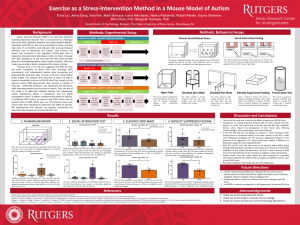Liu, Tonia: Exercise as a Stress-Intervention Method in a Mouse Model of Autism
Title: Exercise as a Stress-Intervention Method in a Mouse Model of Autism
Name: Tonia Liu
Major: Exercise Science
School affiliation: Honors College, School of Arts and Sciences
Programs: Aresty – Research or Conference Funding Recipient
Other contributors: Jenny Dang, Won Kim, Mark Mansour, Ivana Nikodijevic, Neeha Patibanda, Robert Reisler, Gopna Shekaran, Mimi Phan, Benjamin Samuels
Abstract: Autism Spectrum Disorder (ASD) is an extremely prevalent neurodevelopmental disorder that is characterized by challenges with social skills, repetitive behavior, and communication deficits. Individuals with ASD are also more susceptible to stress, and thus high rates of comorbidity exist between ASD and psychological disorders such as depression and anxiety. Past research has shown that mutations in the Engrailed-2 (EN2) gene lead to behavioral and anatomical phenotypes similar to those of people with ASD, allowing us to use mice with the EN2 knock-out (KO) gene as a neurodevelopmental animal model of autism. With this model, we are able to better understand the impact of stress. Previous work in our lab has suggested that EN2 KO mice are more susceptible to stress than their wild-type (WT) counterparts, and subsequently display more anxiety-like and depressive-like behaviors after 10 days of Chronic Social Defeat Stress (CSDS). Our question then becomes: Is there any way to reduce susceptibility to stress in EN2 KO mice? Exercise is known to decrease stress, anxiety, and depression. Thus, the aim of this study is to determine whether exercise has preventative and/or ameliorative effects in populations that are highly susceptible to stress. To better understand the effect of exercise, a traditional CSDS cohort, an exercise and CSDS cohort, and an exercise with no CSDS cohort were run. The behaviors from each cohort were then compared to determine the effect of exercise. Positive results from this study support the role of exercise as a possible intervention approach.
